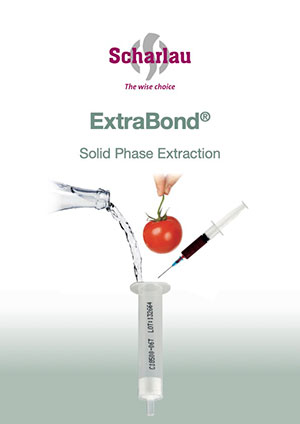Sample preparation with solid-phase extraction
9 de November de 2023Solid Phase Extraction (SPE) has become the ideal method for sample preparation prior to analysis using HPLC, GC, TLC, RIA, NMR… and other analytical techniques. The popularity of this technique has grown dramatically over the past two decades due to advances in analytical instrumentation or robots (automated instrumentation).
SPE is used in various analytical fields such as:
- Chemical
- Food & Beverages
- Pharmaceuticals
- Cosmetics
- Drug Abuse
- Environment
- Agrochemicals
- Clinical and Forensic

Main objectives
The main objectives in using SPE are cleaning, concentrating or changing the solvent (for example, from aqueous to organic). It offers greater selectivity and cleanup than liquid-liquid extraction, as well as less solvent consumption, time saving, and the possibility of automation.
Solid-phase extraction, SPE, is based on the same principle of selective retention as liquid chromatography.
Solid-phase extraction steps
Solid-phase extraction is carried out in syringe-like extraction columns containing modified or unmodified silica gel or other packings. There is a wide variety of columns available with different solid phases, capacities and quantities of phase.
Development of the extraction method
Generally, an SPE method usually consists of 4 stages:
- Conditioning: Sorbent ligands must be “activated” and the bed then equilibrated before applying the sample to obtain a reproducible interaction. This is carried out by passing a volume of suitable solvent through the stationary phase, followed by a volume of liquid similar to the sample matrix. 4 bed volumes are commonly recommended.
- Retention: After applying the sample, the analyte and possibly other matrix components, are retained on the phase due to one or several chemical interactions. Other matrix components can pass through the stage without being retained.
- Wash: This stage should result in the elution of all the unwanted components of the matrix that were retained in the phase at the retention stage. 6-8 bed volumes are commonly recommended.
- Elution: An elution solvent that only “breaks” the bonds between the analyte and the phase should be chosen which results solely in the selective elution of the analyte. 4-5 bed volumes are commonly recommended.
Choosing a phase
The choice of a cartridge is determined by the type and volume of the matrix and the type and concentration of analytes. For an extraction to take place, 3 types of interactions must be taken into account:
- Analyte/phase: are responsible for the retention of the analyte in the stationary phase.
- Analyte/matrix: also affect the retention of the analyte in the stationary phase.
- Matrix/phase: are competing with those of the analyte/phase.
The stationary phase chosen must have a high affinity for either the analytes to be extracted or the interferences to be eliminated. The choice of this phase will define a specific selectivity for the compounds of interest and a loading capacity sufficient for complete adsorption.
Two approaches are possible:
- The analyte of interest can be retained in order to separate it from interferences which may pass through.
- The interferences may be retained and the analytes of interest are allowed to pass through.
There are three main groups of solid-phase packings:
- Silica-based phases
- Non-silica-based phases
- Polymeric phases
The mass of the phase is selected according to the amount of the compound of interest, while the size of the cartridge depends on the sample volume. A 500 mg cartridge, or more, is recommended for samples containing 1 g or more of the compound of interest, and cartridges of 300-500 mg when there is around 0.6–-1 g of target compound. Use 6 mL cartridges for sample volumes of 100 mL to 1 L, while 3 mL cartridges are recommended for smaller volumes (10-100 mL).
What makes ExtraBond® unique?
The Scharlau ExtraBond® solid-phase extraction range includes cartridges with silica, non-silica and polymeric phases.
- The phase and batch number are printed on all ExtraBond® cartridges for better traceability. This helps avoid confusion when handling cartridges with different phases.
- ExtraBond® cartridges are supplied in practical vacuum-sealed bags to ensure maximum protection against humidity and therefore better conservation. In addition, vacuum packaging also protects against possible phase detachment.
ExtraBond® is available in a wide range of formats: Open cartridges from 1 to 60 mL, 10 or 15 mL large reservoir cartridges (LRCs), closed cartridges, glass cartridges, 48- and 96-well extraction plates, flash cartridges and QuEChERS kits.
You can check out the entire range here.
For further information or to enquire about other products or services, please write to helpdesk@scharlab.com.



